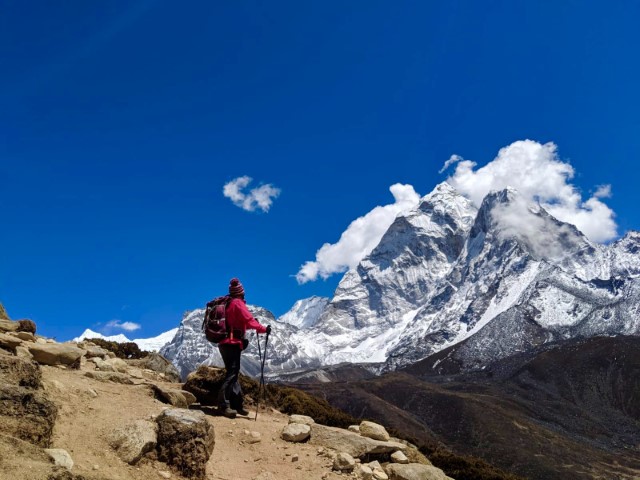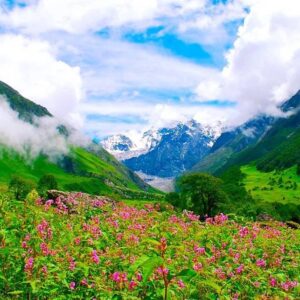Exploring the Himalayas: Top 10 Trekking Peaks in Nepal

Nepal, the land of the Himalayas, beckons adventurers from across the globe with its majestic peaks, stunning landscapes, and rich cultural heritage. Renowned as a trekker’s paradise, Nepal offers a plethora of trekking peaks that cater to both novice and experienced climbers. In this guide, we’ll explore the top 10 trekking peaks in Nepal, each offering a unique blend of challenge and awe-inspiring beauty.
Island Peak (Imja Tse):

Standing tall at 6,189 meters (20,305 feet), Island Peak is one of Nepal’s most popular trekking peaks. Located in the Everest region, this peak offers a challenging ascent coupled with breathtaking views of Mount Everest, Lhotse, and Ama Dablam. The climb involves traversing glaciers and scaling steep ice walls, making it an ideal choice for those seeking a taste of mountaineering adventure.
Read More: The Top 10 Thrilling Treks in Uttarakhand Under 10000 Rupees
Mera Peak:

Rising to an altitude of 6,476 meters (21,247 feet), Mera Peak is the highest trekking peak in Nepal. Situated in the Khumbu region, Mera Peak rewards climbers with panoramic vistas of Everest, Makalu, Cho Oyu, and Kanchenjunga. The climb involves a gradual ascent through pristine forests, high-altitude meadows, and glaciated terrain, culminating in a thrilling summit push.
Lobuche East Peak:

Nestled in the heart of the Everest region, Lobuche East Peak stands at 6,119 meters (20,075 feet). Offering stunning views of Everest, Lhotse, Nuptse, and Ama Dablam, this peak presents a challenging yet achievable climb for seasoned trekkers. The route traverses rugged terrain, steep snow slopes, and rocky ridges, providing a true test of mountaineering skills.
Read More: Top Trekking Trail in Jammu and Kashmir
Yala Peak:

In the Langtang region, Yala Peak is a picturesque trekking peak with an altitude of 5,520 meters (18,110 feet). Surrounded by the stunning landscapes of the Langtang Valley, the climb to Yala Peak offers breathtaking views of the Langtang Himalayan range. The ascent involves traversing snowy slopes and rocky ridges, making it an ideal choice for those seeking a less crowded yet equally rewarding climbing experience.
Pisang Peak:

Located in the Annapurna region, Pisang Peak stands at 6,091 meters (19,983 feet) above sea level. Offering panoramic views of the Annapurna and Manaslu ranges, this peak is renowned for its challenging yet accessible climbing route. The ascent involves a combination of snow and ice climbing, with sections of steep gradient requiring technical expertise.
Read More: 10 Best Snow Treks in India for Snow Lovers
Chulu East Peak:

Situated in the Annapurna region, Chulu East Peak rises to an altitude of 6,584 meters (21,601 feet). Offering stunning views of the Annapurna massif, Dhaulagiri, and Manaslu, this peak provides a challenging yet rewarding climbing experience. To traverse the route, climbers must be well-prepared both physically and mentally, as it includes glacial valleys, high mountain passes, and rocky terrain.
Naya Kanga Peak (Ganja La Chuli):

Located in the Langtang region, Naya Kanga Peak stands at 5,844 meters (19,173 feet) above sea level. This peak is renowned for its diverse climbing terrain, including snow slopes, rocky ridges, and ice walls, offering panoramic views of the Langtang Himalayan range. The ascent involves technical climbing skills, making it suitable for experienced mountaineers.
Read More: The 10 Best Winter Treks in India
Dhampus Peak (Thapa Peak):

Situated in the Annapurna region, Dhampus Peak stands at 6,012 meters (19,724 feet) above sea level. Offering stunning views of the Annapurna and Dhaulagiri ranges, this peak is known for its relatively straightforward climbing route. The ascent involves traversing snow slopes and rocky terrain, making it accessible to climbers with moderate experience.
Ramdung Peak:

Located in the Rolwaling region, Ramdung Peak rises to an altitude of 5,925 meters (19,439 feet) above sea level. This peak offers panoramic views of the rolling Himalayan range and is famous for its excellent and pristine climbing environment. The ascent involves crossing high mountain passes, navigating glaciated terrain, and negotiating technical sections, making it an ideal choice for experienced climbers seeking a wilderness adventure.
Read More: Top 10 Spiritual Treks to Visit in Uttarakhand
Tent Peak (Tharpu Chuli):

Situated in the Annapurna region, Tent Peak stands at 5,663 meters (18,575 feet) above sea level. This peak offers stunning views of the Annapurna massif and Machhapuchhre (Fishtail), and it’s renowned for its relatively easy climbing route. The ascent involves traversing snow slopes and rocky ridges, with sections of moderate gradient requiring basic mountaineering skills.
Conclusion:
Nepal’s trekking peaks offer a gateway to the breathtaking beauty of the Himalayas, coupled with the thrill of adventure and exploration. Whether you’re a seasoned mountaineer or a novice climber, Nepal offers a variety of trekking peaks waiting for you to conquer. So pack your bags, lace up your boots, and embark on an unforgettable journey to the roof of the world.




